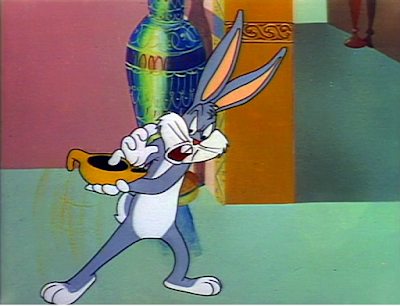
Yes, we're back. But only for a week.
Music expert Daniel Goldmark sent me some information quite a number of months ago. I thought I had turned it into a post, but have discovered I hadn't. I don't want to waste his kindness, so I've come up with something which you'll read here next week. Since I've had a bit of spare time, a full week's worth of posts will appear starting Monday. Then it's back into retirement. (The Yowp blog will have posts monthly through the end of the year but it is essentially done).
Some cartoon fans have pointed out today is the birthday of the Tazmanian Devil. Indeed,
Devil May Hare was released on this date in 1954 according to all trade publications of the time.
But hold on thar! It's actually not his birthday.
Cartoon scholar and noted Release-the-Remaining-Warners-Cartoons champion Jerry Beck has pointed out on many occasions that as soon as a cartoon arrived at a film exchange, a local movie theatre could show it. It may have arrived some time before the "official" release date;
A Wild Hare is a great example.

So it was with
Devil May Hare. To the left is an ad from the
Escanaba Daily Press of Saturday, May 29, 1954. It advertises
Devil May Hare will be on screens the next day. (You can click on the ad to get a larger view).
This doesn't mean the cartoon debuted in a small town in Michigan. That's just the earliest newspaper ad I can find. I don't know if any records exist of when each theatre showed any cartoon, and some newspapers will simply announce "Bugs Bunny cartoon" or "cartoon" without the short being named. After all, if it says "Bugs Bunny cartoon," do you need to know more?
I am not suggesting people who want to celebrate cartoon "birthdays" stop doing it. I merely point out that "official" cartoon release dates are not necessarily birthdates of characters therein. As a side-note, some years back Turner sent out a press release with "birthdays" of Hanna-Barbera characters. It was flat out wrong for the Kellogg's series and I've spent time on-line trying to correct the dates.
Below is another ad, this one from the
Omaha Evening-World Herald. Omahamians (is that what they're called?) got a chance to Dial T for Taz on June 3, 1954.

Incidentally, the Warners featurette
Frontier Days had an official release date of June 12, so it was being screened early in Omaha as well. Oh, and there was another Warners short with a June 19 release date, a Vitaphone Varities ten-minute reel named
When Sports Were King.

Warners was still offering movie houses various shorts, including sports and music reels, something called "Classics of the Screen" that ran 17 to 20 minutes, Technicolor Specials (like
Silver Lightning, the story of a salmon) and George O'Hanlon as Joe McDoakes.
Bugs and other McKimson characters were drawn with hooded eyelids. An example is to the right.
Devil May Hare was written by Sid Marcus. Perhaps that's why the character is an original. Other writers for McKimson were content with purloining characters from radio (eg. Frank Fontaine's John L.C. Sivoney was turned into Pete Puma).
Motion Picture Exhibitor rated it "fair." I suppose it is compared with other Bugs cartoons that year, such as
Bugs and Thugs and
Bewitched Bunny, but I quite like the Devil. There wasn't a lot McKimson and his later writers could do with him (see
Dr. Devil and Mr. Hare for an example. If you dare) and he was eventually turned into a TV cartoon sitcom character for the kiddies.

Herman Cohen, Rod Scribner, Phil De Lara and Chuck McKimson animated this short, with Bob Givens laying it out. Dick Thomas supplied the stylised forest background art that isn't much more elaborate than his later work at Hanna-Barbera. By the time this was released, they were all unemployed. The McKimson unit was eliminated in March 1953 but, apparently after some debate, reactivated almost a year later.
We have more about the McKimson family and the T. Devil
in this post.
 It’s always a good day to read about restored cartoons that can find their way to your home.
It’s always a good day to read about restored cartoons that can find their way to your home.

























































